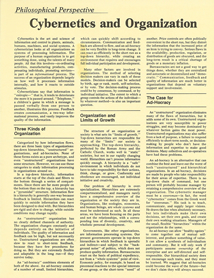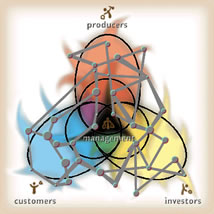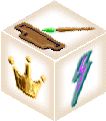Wiring
the Network - to WORK |
| In At Home in the Universe, Stewart kauffman presented his concept of Patch Theory. He was concerned with what caused networks to grid lock or be so loosely connected that they were incapable of coordinated action. He developed analytical tools to find out how to create the values which optimize a network while facilitating both flexibility and focus. He raised the question in his book if Patch Theory would work equally well in the realm of organization. The structure of organization has been an issue which has long attracted my attention. How organizational structures functioned was the basis of my CyberCon concept of the 60s and 70s and today is a key aspect in the design and facilitation of ValueWebs® - a concept which emerged from our work in the mid 80s. Since 1996, we have tested Patch Theory in the realms of collaborative group process and organization. It is now an integral part of the Taylor Method. We call it PatchWorks. |
 |
From CyberCon to Patch Theory to ParchWorks™ practice has for me been a 45 year quest. Can a mind-like organization be brought into being? The answer is yes - actually, nothing else is ever created. The real question is a question of health. Most organizations - as an organism - are not healthy. They act in a neurotic and repressed way. They are not examples of “clear cognitive functioning.” They are sick and they cause the people within them to act in bizarre ways.
It has been a premise of MG Taylor, from the beginning, that organizations are best understood as networks. In recent years, a great deal of science has been done on network theory. Over the last 35 years we have applied the network concept to our work, the organization of it and in some cases to the organizational transformation of our clients.
There is definitely a case for the network-organization argument yet we are just on the threshold of a critical mass of information, knowledge and practical application to make it so. There is no question however, after 13 years of testing, that Patch Theory can be applied to human organization in a beneficial way. |
|
 |
 |
| The ValueWeb, the Zone of Emergence and PatchWorks form a new theory and practice of organization. The are also techniques which can be employed on a tactical and task level when running a project of a collaborative design session. ValueWeb and PatchWorks organizations are designed to scale by many orders of magnitude while avoiding the usual problems which are the consequence of large organizational size. In my present thinking, I believe them to be a primary transition organizational form as we move to the next paradigm of social-economic-ecological order. Given the nature of large scale social transformations, it is not possible to see clearly post-transformational organizational requirements. However, given the organic aspects of PatchWorks and ValueWeb architectures and their affinity with nature-built systems which have withstood the test of time, it is a good bet that these structure-processes will have a place in future societies for a long time to come. |
|
Matt
Taylor
September 16, 2002
Palo Alto
November 12, 2010
Los Gatos

SolutionBox
voice of this document:
INSIGHT • POLICY • PROGRAM
|
click on graphic for explanation of SolutionBox |
posted: September 16, 2002
revised:
Novenber 16, 2010
• 20021012.452590.mt • 20081016.341512.mt •
• 20090216.311201.mt • 2010112.570409.mt •
• 20101115.300812.mt • 20101116.999910.mt •
Copyright©
Matt Taylor 1977, 2002, 2010
Certain aspects described herein are patented and in patent pending
me@matttaylor.com
note:
this document is about 12% finished
|
|
|